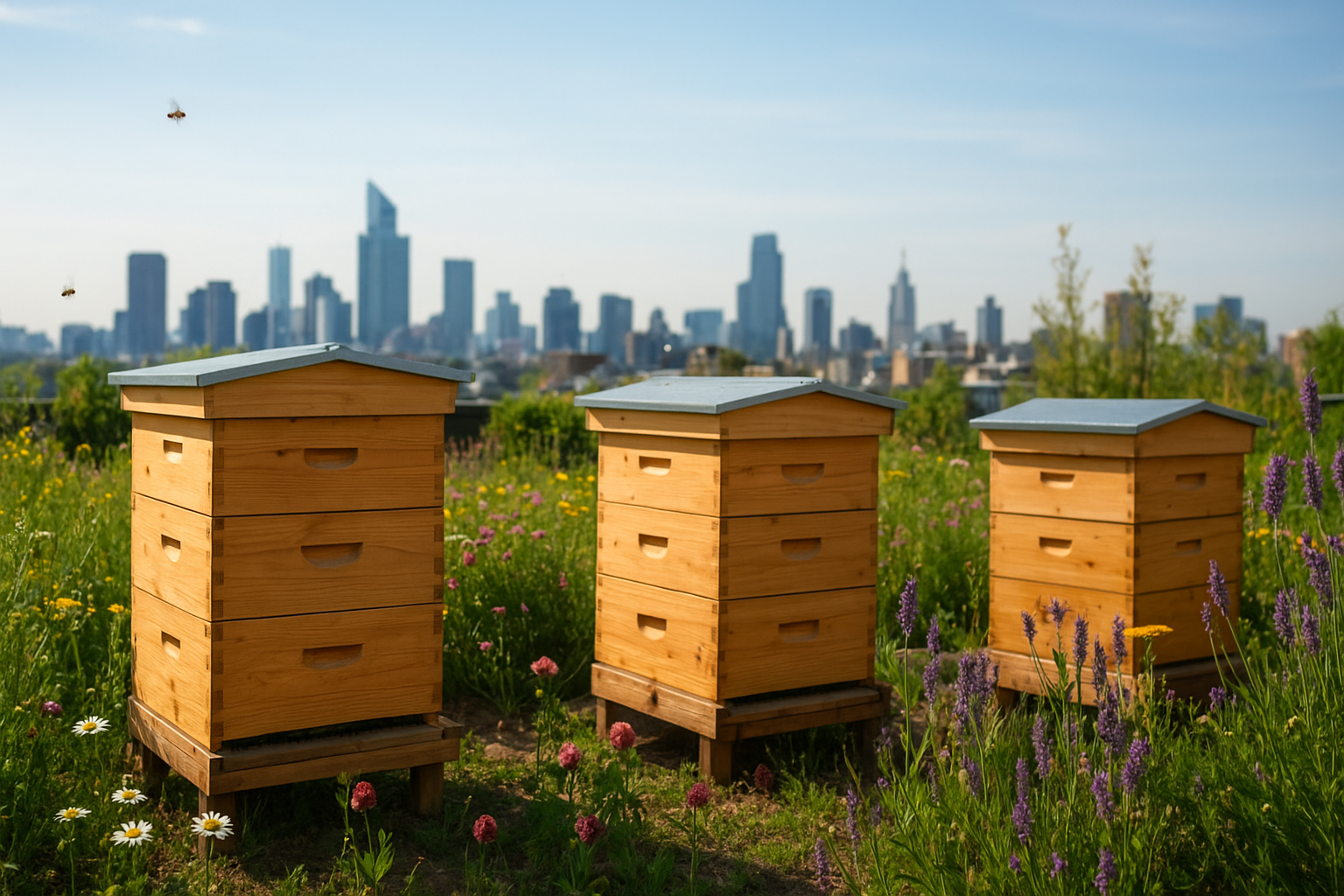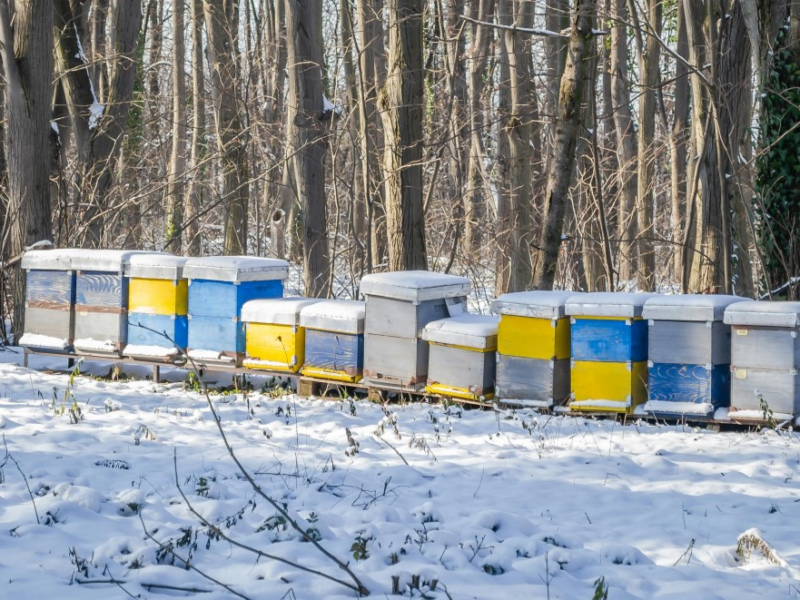🐝 1. Introduction: The Buzz About Urban Beekeeping
Urban beekeeping has transformed from a niche hobby into a global sustainability movement. Cities like New York, London, Paris, and Berlin are now home to thousands of rooftop hives. Why? Because bees can thrive even in urban settings — provided beekeepers offer proper care, habitat, and respect for local rules.
Urban beekeeping bridges nature and modern living. With a small rooftop, balcony, or backyard, city dwellers can produce organic honey, pollinate urban gardens, and support biodiversity.
🌼 2. Why Cities Need Bees
Cities may seem unlikely places for bees, but they often provide a surprisingly rich ecosystem. Urban gardens, parks, and green roofs offer diverse nectar sources, while reduced pesticide use (compared to large-scale farms) benefits bee health.
Key Benefits of Urban Bees:
- 🌸 Improved pollination in community gardens
- 🥦 Higher yields in urban agriculture
- 💨 Cleaner air through more green spaces
- 🐝 Awareness and education for city residents
Urban bees pollinate herbs, flowers, and even rooftop vegetables. In fact, some studies show that urban honey can contain more floral diversity than rural honey.
⚖️ 3. Is Urban Beekeeping Legal?
Before setting up hives, research local laws. Many cities now support beekeeping but require registration or permits.
Common requirements include:
- Hive registration with local authorities
- Safe distance from property lines
- Flyway barriers (hedges or fences)
- Limited number of hives per property
Tip: Contact your local agricultural department or beekeeping association for updated regulations.
🏠 4. Best Locations for City Beehives
Ideal hive placement maximizes sunlight, minimizes wind, and provides safe access.
Whether on a rooftop, terrace, or small backyard, positioning is key.
Urban Hive Location Tips:
- Morning sun exposure
- Easy water source (shallow dish or fountain)
- Shade in afternoon heat
- Wind protection from walls or shrubs
- Safe flight path (avoid pedestrian areas)
⚙️ 5. Equipment Needed for Urban Beekeeping
City beekeepers need compact and efficient setups to save space.
Basic Gear:
- 1–2 Langstroth or Flow hives
- Bee suit, gloves, veil
- Smoker and hive tool
- Feeder and water source
- Compact honey extractor
Optional: Install an observation window or smart hive sensor for temperature, humidity, and hive activity tracking.
🐝 6. Choosing the Right Bee Species
Not all bee species adapt equally well to city life. You’ll want docile, disease-resistant bees.
Best Urban Bee Breeds:
- Apis mellifera ligustica (Italian bees): Gentle and productive
- Apis mellifera carnica (Carniolan bees): Calm, cold-resistant
- Buckfast bees: Hybrid with excellent temperament and hygiene
Avoid overly defensive colonies — city neighbors will thank you!
🌿 7. Setting Up a Rooftop or Balcony Hive
Rooftop setups require sturdy platforms to support hive weight (50–100 kg). Ensure easy access for inspections and honey harvest.
Steps:
- Choose a flat, stable surface
- Place hive stand 10–15 cm off the ground
- Orient the entrance southeast
- Add potted flowers around the hive
- Secure the hive against strong winds

🍯 8. Managing Bees in Limited Space
Urban beekeepers must master efficiency — less space, but more observation.
Tips for Compact Hive Management:
- Use vertical hive systems (stacked supers)
- Regular inspections (every 10–14 days)
- Prevent swarming early
- Provide extra ventilation in summer
- Maintain water sources to prevent bees from visiting neighbors’ pools
🌬️ 9. Dealing with Urban Challenges
Challenges unique to cities include:
- Heat from concrete and rooftops
- Air pollution and limited forage
- Noise and human activity
Solutions:
- Shade cloths during hot weather
- Pollution-tolerant plants (lavender, thyme, sunflowers)
- Hive placement near rooftop gardens or community parks
🍯 10. Harvesting Honey in the City
Urban honey often has rich, complex flavors from diverse city flowers — clover, lavender, mint, and fruit trees.
Harvest Tips:
- Harvest 2–3 times per year (spring–autumn)
- Use a small, quiet extractor indoors
- Filter honey naturally to preserve enzymes
- Store in glass jars away from light
👨👩🌾 11. Community and Education
Urban beekeeping fosters community awareness and sustainability. Many beekeepers share their rooftops with schools or run workshops.
Start an urban beekeeping club — it’s a great way to connect, share honey, and educate about pollinator protection.
🧯 12. Safety and Neighbors
Respecting neighbors ensures harmony.
- Keep hives out of direct sight
- Share honey as goodwill
- Educate about bee behavior (“they’re not wasps”)
- Post signs like “Caution: Bees at Work”
🌍 13. Environmental Impact
Urban bees improve local ecosystems by supporting plant diversity and food security. Rooftop gardens with bees can increase fruit yield by up to 40%.
Cities with bees are cleaner, greener, and healthier.
🐝 14. Common Myths About Urban Beekeeping
| Myth | Reality |
|---|---|
| Bees can’t live in cities | Bees thrive in cities with diverse flora |
| Urban honey is toxic | Tests show urban honey is safe and often richer |
| Beekeeping attracts swarms | Proper management prevents swarming |
| Bees disturb people | Docile bees rarely sting if unprovoked |
❓ 16. FAQs
Q1: Can I keep bees on a balcony?
Yes, if space and neighbors allow. Use small hives (nucs) and keep water nearby.
Q2: How much honey can one urban hive produce?
Between 15–25 kg per season, depending on floral availability.
Q3: Do urban bees need special food?
Usually not, but provide sugar syrup during nectar shortages.
Q4: Are urban bees exposed to pollution?
Minimal. Studies show heavy metals in urban honey are below safety limits.
Q5: How do I start urban beekeeping?
Attend a local beekeeping course, get legal permits, and start with one hive.
🌼 17. Conclusion
Urban beekeeping is more than a hobby — it’s a movement for ecological balance.
By keeping bees in the heart of our cities, we bridge the gap between humans and nature. Every rooftop hive becomes a tiny ecosystem, supporting pollinators, plants, and people alike.
Whether you live in an apartment or manage a city garden, your bees can make a difference — one flower, one jar of honey, and one buzzing colony at a time. 🐝



